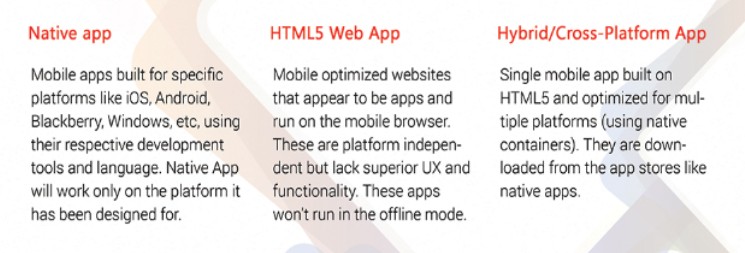Which way to go: Native, Html5, or Hybrid?
In a world that is progressively social and open, portable applications play a key role, and have changed the emphasis from what’s on the Web, to the applications on our smartphone. Versatile applications are no more an alternative, they’re a basic. You require a versatile application, yet where do you begin? Many elements have influence in your versatile technique, for example, your group’s improvement abilities, required gadget usefulness, the significance of security, logged off capacity, interoperability, and so on, that must be considered.

There are mainly 3 options of mobile application development:

Native Mobile Applications
More or less, local applications give the best ease of use, the best elements, and the best general versatile experience. There are a few things you just get with local applications:
Multi touch – Twofold taps, squeeze spread, and other compound UI motions.
Graphics API – The local stage gives you the speediest design, which may not be a major ordeal in case you’re demonstrating a static screen with just a couple of components, or a major ordeal in case you’re utilizing a great deal of information and require a quick invigorate.
Fluid animation – Identified with the quick representation API is the capacity to have fluid liveliness. This is particularly vital in gaming, exceedingly intelligent reporting, or strong computational calculations for changing photographs and sounds.
Built-in components – The camera, location book, geolocation, and different elements local to the gadget can be consistently incorporated into versatile applications. Another imperative implicit parts is scrambled capacity, yet more about that later.
Usability – The local stage is the thing that individuals are acclimated to, thus when you include that recognition with the local’s majority highlights they expect, you have an application that is out and out simpler to utilize.
Documentation – There are more than 2500 books alone for iOS and Android advancement, with numerous more articles, blog entries, and nitty gritty specialized strings on destinations like StackOverflow.
HTML5 Web Apps
HTML5 is a dialect that empowers designers to make rich online applications that keep running on any gadget by means of the web program; engineers can “compose once, run all over”. A versatile venture may need to make a substantial number of distinctive applications to bolster a horde of differing offices and useful undertakings, which makes HTML5 more alluring financially.
Defenders of HTML5 trust that the quality is practically identical to that of a local application. Likewise, it is less demanding to adapt and roll out improvements to your application in light of the fact that you are not experiencing an application store.
Contentions against HTML5 incorporate execution, hindrance of heading off to a URL rather than downloading an application, and absence of program similarity (not all portable programs bolster the same subset of components).
Hybrid App
The last choice is to make a half and half endeavor portable application, which is composed in HTML5 however wrapped in a local “compartment”, and made by means of cross-stage advancement devices, for example, PhoneGap and Sencha. It would seem that a local application, can be downloaded from an endeavor application store, and can even access on-gadget highlights, however doesn’t contain an ounce of Objective-C or Java code. The engineer ordinarily needs to utilize HTML5, CSS, and JavaScript inside of the stage environment, abilities which are less demanding and less expensive to discover than Objective-C or Java.
One downside to this methodology is timing: there may be issues while sitting tight for your stage to actualize new usefulness discharged by a working framework. This methodology is picking up in prominence: Gartner predicts that by 2016, more than half of all applications conveyed will be crossover.
At last, if your endeavor portable applications oblige access to gadget particular components or predominant response time required for amusements rate advanced applications (video), then local is your most logical option.
On the off chance that you are expense obliged and need to create numerous applications for some stages, or need to do quick prototyping preceding building up the full-highlighted application (run of the mill with a commercial organization), pick HTML5.
In the event that you are some place between the two, well then go half and half.

